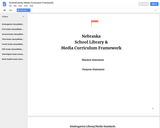
ESU 10 School Librarians unpacked ELA multiple literacy standards for grades K-12.
- Subject:
- English Language Arts
- Reading Informational Text
- Reading Literature
- Material Type:
- Teaching/Learning Strategy
- Author:
- ESU 10
- Date Added:
- 09/18/2018

ESU 10 School Librarians unpacked ELA multiple literacy standards for grades K-12.

Word Count: 44933
(Note: This resource's metadata has been created automatically by reformatting and/or combining the information that the author initially provided as part of a bulk import process.)
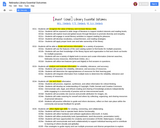
These essential outcomes are based on the AASL, ISTE Standards for Students, and the NE ELA Standards. Use this document in conjunction with the Nebraska Library Purpose Template.

Looking for a place to start when it comes to library purpose? Use this template to articulate what your library can provide for staff and students. This document correlates with the Nebraska Library Essential Outcomes document.

This is an accompanying teacher's guide to the graphic novel "Fighting for America: Nisei Soldiers. The book is a compilation of 6 Nisei, second-generation Japanese Americans, veteran's oral histories. These emotional first-person accounts are visceral and graphically moving. These veterans take us on the journey into intelligence units, into the life of a medic, and into gripping and pivotal moments of the Second World War. The books are available in multiple bookstores and library systems. For more information on where to find this novel, contact education@wingluke.org.

The Steve-O Stories
Short Description:
Shortly after his 51st birthday, Steve Andrews was diagnosed with cancer. Stage 4. No One Fights Alone: The Steve-O Stories is the story of Steve's battle against the disease. And, mostly, it is the story of his exceptional character and love of life, family, friends, and God that gave him the strength, courage, and grace to live an amazing life, all the way to the end.
Word Count: 50968
(Note: This resource's metadata has been created automatically by reformatting and/or combining the information that the author initially provided as part of a bulk import process.)

Group Novel Analysis Unit:Students work through and discuss a novel of significant literary merit in five sessions before selecting a topic upon which to compose an analytical essay.

This resource provides lecture notes and writing assignments for the study of a novel - in this case, Aldous Huxley's Brave New World. These notes and assignments, however, can be adapted and applied to practically any novel. Unless otherwise noted, this resource is licensed under CC BY-NC-SA.
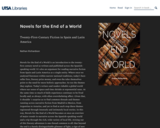
Twenty-First-Century Fiction in Spain and Latin America
Short Description:
Novels for the End of a World is an introduction to the twenty-first century novel as written and published across the Spanish-speaking world. It's also an argument for reading narrative fiction from Spain and Latin America as a single entity. Where once we analyzed literature within narrow national traditions, today’s best-seller lists, literary prize money, and even the tales themselves point to the need for more holistic approaches. So too the themes they explore. Today’s writers and readers inhabit a global world where our sense of space and time shrinks at exponential rates. At the same time so much of daily experience continues to be lived locally and, as always, with often overwhelming affect. Given that, it shouldn´t surprise us to find common threads and themes running across narrative fiction from Madrid to Mexico, from Argentina to Asturias, and yet to find at each stop these themes registered through intensely and intimately local stories. In this way, Novels for the End of a World becomes at once an overview of major trends in narrative across the Spanish-speaking world and a trip through the rich, wide variety of local life. Arising out of this literary adventure is one thread common to all: that beyond the end is a barely distinguishable glimmer of light, a sign of new ways for a new world.
Long Description:
Novels for the End of a World is an introduction to the twenty-first century novel as written and published across the Spanish-speaking world. It is also an argument for reading narrative fiction from Spain and Latin America as a single entity. Where once we analyzed narrative fiction within narrow national or continental traditions, today’s best-seller lists, literary prize money, and even the fictions themselves point to the need for more holistic approaches. Today Sergio Pitol reads Vila-Matas while Cercas writes of Bolaño reading Cercas. Meanwhile Spanish publishing houses such as Anagrama and even Planeta dole out prize money to increasingly young and unknown Latin American authors. For general readers searching out their latest read on sites like Amazon or Casa del Libro, national distinctions simply don’t exist. To search for Luiselli is to discover Fernández Mallo, while Marías will lead you to Rosero. Where they´re from doesn´t feature and likely doesn´t much matter.
While a Bourdeauian description of this newly broadened field of cultural production, or Spanish-language Republic of Letters—to borrow two potentially useful terms—needs to be developed, Novels for the End of a World is a more humble attempt to practice in a limited fashion what it might look like to read novels from across the Spanish-speaking world as a whole. Novels reads one work against another and then another. While it pays plenty of attention to historical context, it gives little heed to local literary traditions. It assumes rather that these works can and should be read as addressing common concerns across a single cultural and linguistic milieux.
The monograph´s name is inspired in the title of Mexican author Yuri Herrera´s Signs Preceding the End of the World (2011), a reading of which headlines the study. The guiding thematic of the work is a common anxiety surrounding the notion of an end—of times, of places, of meanings, and even of lives. In Herrera´s novel both traditional Mexican society and traditional Mexico/USA divisions collapse under the weight of so much migration—material and virtual. The divisions give way under the weight of hybrid world and identities so novel that they exceed the very possibilities of the language that would describe them. In some novels the sense of an ending is manifest via readings of economic crisis (Gopeguí´s Reality; Eloy Martínez´s Tango Singer; Aira´s Shantytown). In others the ending is more violent (Rosero´s The Armies; Rey Rosa´s Enchanted Stones; Roncagliolo´s Red April; Pron´s The Spirit of My Father and Zambra´s Ways of Going Home). Still others register a more sinister, because seemingly innocuous, collapse brought on by political and cultural hegemonies (Lalo´s Simone; Guerra´s Everyone Leaves; Santos Mayra´s Any Wednesday I´m Yours). The study concludes with a look at a collection of short stories by a “Spanish” artist writing in Asturian, Xuan Bello, whose intensely local yet equally cosmopolitan work, situated within the illustrative context of contemporary Spanish economic, political, and cultural development, may offer a final “sign at the end,” a way forward when all paths—economic, political, and cultural—appear to have come to naught.
Word Count: 109324
ISBN: 9780991504374
(Note: This resource's metadata has been created automatically by reformatting and/or combining the information that the author initially provided as part of a bulk import process.)

Version 1.25
Short Description:
The OER by Discipline Guide: University of Calgary supports faculty in locating quality open educational resources in their subject area by providing curated lists of OER organized according to the faculties, departments, and subjects at UCalgary. The Open Educational Resources within this guide have been evaluated by faculty, librarians, and other relevant parties prior to inclusion. This guide will be updated periodically as new resources are identified, evaluated, and adopted.
Long Description:
The OER by Discipline Guide: University of Calgary developed by Libraries and Cultural Resources staff supports faculty in locating quality open educational resources in their subject area by providing curated lists of OER organized according to the faculties, departments, and subjects at UCalgary. The Open Educational Resources within this guide have been evaluated by faculty, librarians, and other relevant parties prior to inclusion. The lists of OER in each discipline are not intended to be comprehensive, but rather to provide a sample of the key resources available. This guide will be updated periodically as new resources are identified, evaluated, and adopted.
This book is a cloned version of OER by Discipline: University of Manitoba edited by University of Manitoba Libraries is licensed under a Creative Commons Attribution 4.0 International License, except where otherwise noted. It has been adapted from the original source.
Word Count: 86236
ISBN: 978-0-88953-484-1
(Note: This resource's metadata has been created automatically by reformatting and/or combining the information that the author initially provided as part of a bulk import process.)
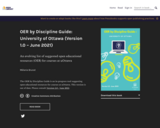
An evolving list of suggested open educational resources (OER) for courses at uOttawa
Short Description:
The OER by Discipline Guide is an in-progress tool suggesting open educational resources for courses at uOttawa. This version is out of date. Please consult Version 2.0 - June 2022.
Long Description:
The OER by Discipline Guide: University of Ottawa is an in-progress tool suggesting open educational resources for specific courses at uOttawa. Its purpose is to help professors get acquainted with existing OER in their disciplines and facilitate their use. It will be updated annually as new resources are identified. This version is out of date. Please consult Version 2.0 – June 2022.
Word Count: 45375
(Note: This resource's metadata has been created automatically by reformatting and/or combining the information that the author initially provided as part of a bulk import process.)

A list of suggested open educational resources (OER) for courses at uOttawa
Short Description:
The OER by Discipline Guide is a tool suggesting open educational resources for courses at uOttawa. This version supersedes Version 1.0 – June 2021. Consult this online version for the latest updates. This guide also has a French version: Guide REL par discipline : Université d'Ottawa (version 2.0 - juin 2022). Already using an OER in your course? Let us know by filling out the Adoption Form.
Long Description:
The OER by Discipline Guide: University of Ottawa is a tool suggesting open educational resources for specific courses at uOttawa. Its purpose is to help professors (and students) get acquainted with existing OER in their disciplines and facilitate their use. This version supersedes Version 1.0 – June 2021. Consult this online version for the latest updates.
This guide also has a French version: Guide REL par discipline : Université d’Ottawa (version 2.0 – juin 2022).
Already using an OER in your course? Let us know by filling out the Adoption Form.
Word Count: 117381
(Note: This resource's metadata has been created automatically by reformatting and/or combining the information that the author initially provided as part of a bulk import process.)
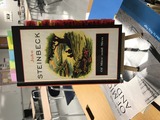
Activity Description: This activity is actually three different discussion-based activities to be used in a station rotation discussion day format. It does require some prework with the double journal note-taking graphic organizer included in the resources. This station rotation discussion format could be used with each chapter, a grouping of chapters, or at the end of the book. If you are encompassing the entire book, this activity will most likely take several days.Time needed for activity: 30-45 (10ish minutes per station)Resources needed for activity: student notes using the double journal note-taking graphic organizer (linked here and as a PDF in the resources) paper for timelines or internet access to https://time.graphics/ or another online timeline maker, internet access to an online discussion tool like https://pinup.com/ or a discussion forum on your LMS.Assessment strategies: See the attached rubrics for possible assessment methods.

Activity Description: This activity is actually four different discussion-based activities to be used in a station rotation discussion day format. It does require some prework with the double journal note-taking graphic organizer included in the resources. Time needed for activity: 45-60 minutesResources needed for activity: student notes using the double journal note-taking graphic organizer; paper, sticky notes, and markers for timelines, and internet access to LMS. Assessment: Rubrics "Of Mice and Men End of the Novel Project" by Raeanna Carlson is licensed under CC BY-NC 4.0 / A derivative from the original work
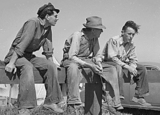
John Steinbeck’s novella Of Mice and Men tells the tragic story of George Milton and Lennie Small, two migrant ranch workers in Salinas, California. Published in 1937 and set during the Great Depression of the 1930s, Of Mice and Men explores the themes of loneliness and isolation.
(Digital Public Library of America (DPLA) Primary Source Sets are designed to help students develop critical thinking skills by exploring topics in history, literature, and culture through primary sources. Drawing online materials from libraries, archives, and museums across the United States, the sets use letters, photographs, posters, oral histories, video clips, sheet music, and more. Each set includes a topic overview, ten to fifteen primary sources, links to related resources, and a teaching guide.)
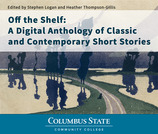
This anthology is an online collection of short fiction created to serve as an accessible and affordable option for college-level introduction to fictions courses. It is part of a growing movement to promote OERs (Open Educational Resources) in order to reduce textbook costs for students. The fiction included in this anthology represents a diverse selection of authors from the nineteenth century to today, and it also contains support material including an introduction, key concepts, literary terminology and literary theories.

Hovering in the Last Chapter of Cancer
Short Description:
A life lived and enjoyed with deepening faith while balancing breast cancer.
Word Count: 77845
(Note: This resource's metadata has been created automatically by reformatting and/or combining the information that the author initially provided as part of a bulk import process.)
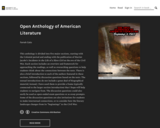
This anthology is divided into five major sections, starting with the Colonial period and ending with the publication of Harriet Jacobs’s Incidents in the Life of a Slave Girl on the eve of the Civil War. Each section includes an overview and framework for approaching the readings, as well as overarching questions to help students think about the connections between the texts. There is also a brief introduction to each of the authors featured in these sections, followed by discussion questions based on the texts. The textual introductions do not include a great deal of biographical material; instead, I have used them to provide a frame (typically connected to the larger section introduction) that I hope will help students to navigate from. The discussion questions could also easily be used as open-ended exam questions or as essay prompts. Some of the discussion questions are also invitations for students to make intertextual connections, or to consider how the literary landscape changes from its “beginnings” to the Civil War.
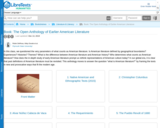
In this class, we questioned the very parameters of what counts as American literature. Is American literature defined by geographical boundaries? Experiences? Histories? Themes? What is the difference between American literature and American history? Who determines what counts as American literature? How does the in-depth study of early American literature prompt us rethink representations of American culture today? In our global era, it is clear that past definitions of American literature must be revisited. This anthology moves to answer the question “what is American literature?” by framing the texts in new and provocative ways that fit the modern age.
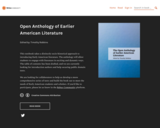
This textbook takes a distinctly socio-historical approach to introducing Early American literature. The anthology will allow students to engage with literature in exciting and dynamic ways. The table of contents has been drafted, and we are currently looking for introduction authors and help securing public domain texts.